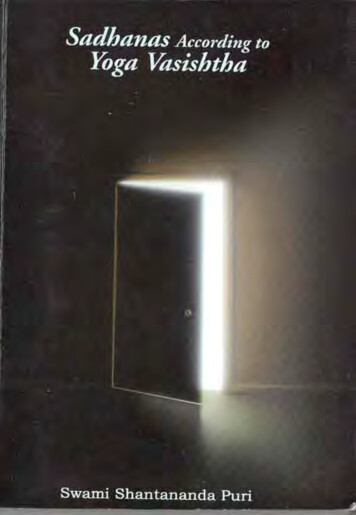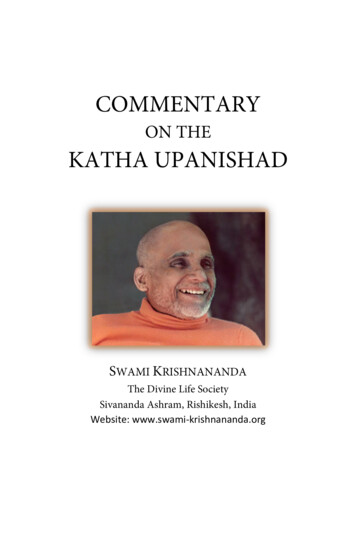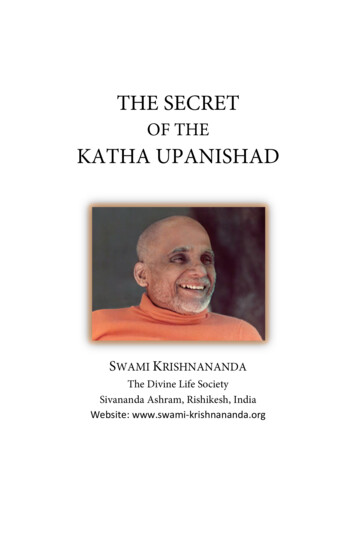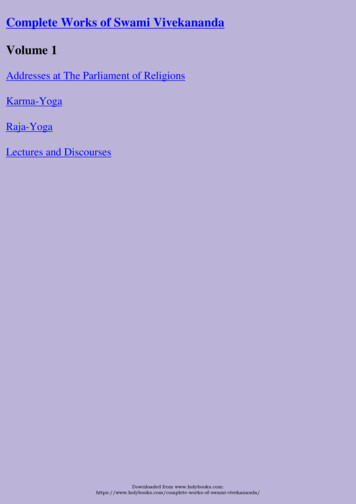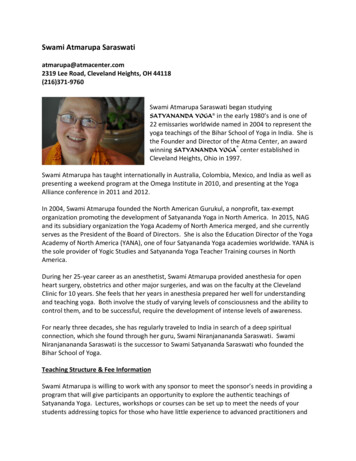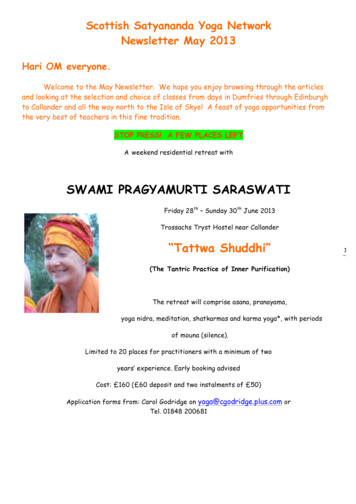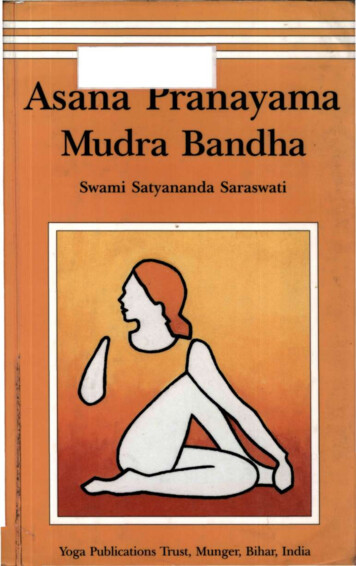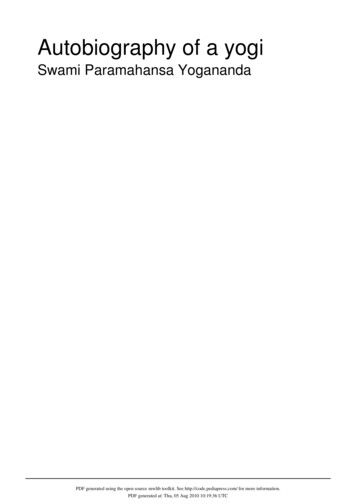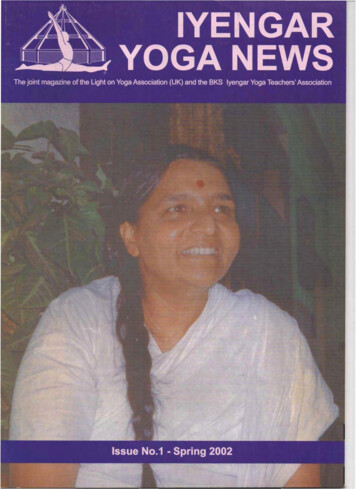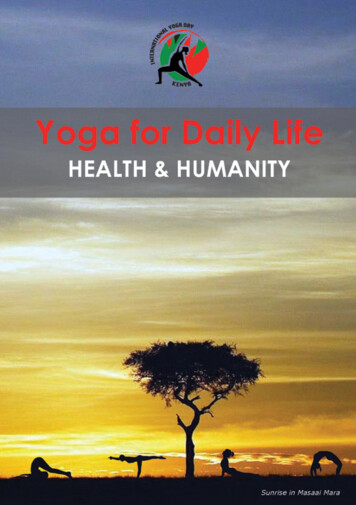
Transcription
Yoga Swami Svatmarama. Hatha yoga pradipika
Yoga Swami Svatmarama. Hatha yoga pradipikaTable of ContentsYoga Swami Svatmarama.1HATHA YOGA PRADIPIKA.2FOREWORD by B K S Iyengar.8TRANSLATOR'S NOTE.9INTRODUCTION.15THE FUNDAMENTAL PRINCIPLES.15THE PREREQUISITES.20YOGA AND THE ART OF HEALING.24THE ASANAS.39THE WAY OF LIFE OF A YOGI.43THE RIVER OF LIFE.43THE PURIFICATION OF THE NADIS.51KUMBHAKA.58ACTIVE YOGA.58THE MUDRAS.62THE NECTAR.67THE BANDHAS.71THE SHAKTI.75PASSIVE YOGA.75SAMADHI.80MIND AND BREATH.85THE DISSOLUTION.87THE SHAMBHAVI MUDRA AND THE INNER LIGHT.93NADA, THE INNER SOUND.100EPILOGUE.0i
HATHA YOGA PRADIPIKAForeword byB K S IyengarCommentary byHans Ulrich RiekerTranslated byElsy Becherer This edition published by The Aquarian Press 1992 13579108642English translation Herder and Herder, Inc., an imprint of Crossroad/Continuum, Inc.Illustrations by Stephen SturgessHATHA YOGA PRADIPIKA1
FOREWORD by B K S IyengarThe Hatha yoga pradipika of Svatmarama is one of the most important yoga texts, and Hans UlrichRieker's translation and commentary have long been valuable to yoga students as a complement totheir practice and study.Hatha yoga, or hatha vidya (the science of hatha yoga) is commonly misunderstood andmisrepresented as being simply a physical culture, divorced from spiritual goals. Hans Ulrich Riekershows the error of this idea by explaining the changes which take place, through the practice of hathayoga, in the practitioner's body, mind and self. He makes the reader aware of the subjectivetransformation that occurs as the consciousness penetrates inwards towards the Self, and as the Selfdiffuses outwards. He shows that hatha yoga is not just physical exercise, but an integrated scienceleading towards spiritual evolution.We are caught up in emotions like lust (kama), anger (krodha), greed (lobha), infatuation (moha),pride (ynadha) and malice (matsarya). Hatha yoga helps us to overcome these obstacles andhindrances to spiritual development. It is a biochemical, psycho physiological and psycho spiritualscience which deals with the moral, mental, intellectual and spiritual aspects of man, as well as thephysical and physiological. We can clarify our understanding of hatha yoga by first examining fiveimportant underlying concepts: mind, knowledge, aims of life, health and afflictions.MindMan is known as manava (human), as he is descended from Manu, the father of mankind who is saidto be the son of Brahma, the Creator of the world. The word mana or manas (mind) comes from theroot man, meaning to think. Man is one who possesses a mind.Manas means mind, intellect, thought, design, purpose and will. It is the internal organiser of thesenses of perception and the organs of action, and the external organiser of intelligence,consciousness and theSelf. Man is graced with this special sense so that he can en)oy the pleasures of the world, or seekemancipation and freedom(moksa) from worldly objects.KnowledgeKnowledge means acquaintance with facts, truth or principles by study or investigation. The mind,which is endowed with the faculty of discrimination, desires the achievement of certain aims in life.Knowledge (jnana) is of two types: laukilfa jnana, which concerns matters of the world, and vaidikajnana, the knowledge of the Self (relating to the Vedas, or spiritual knowledge). Both are essentialfor living in the world, as well as for spiritual evolution. Through yogic practice, the two kinds ofknowledge encourage development of a balanced frame of mind in all circumstances.Aims of LifeThe sages of old discovered the means for the betterment of life and called them aims orpurusarthas.They are duty {dharma), the acquisition of wealth (artha) (necessary to free oneself fromdependence on others), the gratification of desires (kama) and emancipation or final beatitudeFOREWORD by B K S Iyengar2
Yoga Swami Svatmarama. Hatha yoga pradipika(moksa). Moksa is the deliverance of the Self from its entanglement with the material world:freedom from body, senses, vital energy, mind, intellect and consciousness.Dharma, artha and kama areimportant in matters of worldly life. Dharma and moksa should befollowed judiciously if they are to lead to Self realisation.Patanjli, at the end of the Yoga Sutras, concludes that the practice of yoga frees a yogi from the aimsof life and the qualities of nature (gunas), so that he can reach the final destination kaivalya ormoksa.Health and HarmonyTo acquire knowledge whether mundane or spiritual bodily health, mental poise, clarity andmaturity of intelligence are essential.Health begets happiness and inspires one to further one's knowledge of the world and of the Self.Health means perfect harmony in our respiratory, circulatory, digestive, endocrine, nervous andgenito excretory systems, and peace of mind. Hatha yoga practices are designed to bring about suchharmony.AfflictionsHuman beings aresubject to afflictions of three types: physical, mental and spiritual (adhyatmika,adhidaivika and adhibhautika). Afflictions arising through self abuse and self inflictions areadhyatmika. Physical and organic diseases are caused by an imbalance of the elements in the body(earth, water, fire, air and ether) which disturbs its correct functioning. These are called adhibhautikadiseases. Misfortunes such as snake bites and scorpion stings are also classified as adhibhautika.Genetic and allergic disease or diseases arising from one's past deeds ( arma) are known asadhidaivika. The practice of hatha yoga will help to overcome all three types of affliction.Hatha Yoga or Hatha VidyaHatha means to stick fast, to be devoted and to hold closely or firmly. Yoga means to unite, toassociate, to yoke and to join. It also means zeal, endeavour, fixing the mind on one point, holdingthe body in a steady posture, contemplation and meditation. Vidya means knowledge, art andscience.The Goddess Parvati, the wife of Lord Siva, approached her Lord the seed of all knowledge forguidance to ease the suffering of humanity. Lord Siva revealed to her the greatest of all sciences forthe holistic development of man the science of hatha yoga.On receiving yogic knowledge from Siva, Parvati imparted it to Brahma, who taught it to hischildren born of his own will, the sages such as Narada, Sanaka and Sanatkumara, who passed it onto Vasista and others. Hatha vidya was set down in the Hatha yoga pradipika by YogiSvatmarama who, it is thought, lived between the twelfth and fifteenth centuries. The Pradipika hasthus been referred to as a nebrively recent addition to the literature of yoga, which goes back to theVedas (1500 bc). In fact, Svatmarama was part of the long unbroken line of sages or rishis,descended from Brahma, by whom hatha vidya was passed down through the ages.FOREWORD by B K S Iyengar3
Yoga Swami Svatmarama. Hatha yoga pradipikaAt the very beginning of his treatise, in verses 4 9, Svatmarama invokes the names of many of thesesages who came before him and who practised and passed on the noble art of hatha yoga. Aconsideration of this list of names leads to the conclusion that the yoga described by Svatmarama iscontemporary with that of Patanjali (whose Yoga Sutras were also a codification of long establishedtheory and practice).If Patanjali, in the Yoga Sutras, codified the eight limbs of yoga (astanga yoga), Svatmarama did thesame for hatha yoga. If the former is a scholarly exposition with gems of wisdom woven together,the latter is a direct practical and technical handbook.Because Svatmarama's treatise incorporated ideas from the Yoga Sutras, the Yoga Upanisads, thePuranas, the Bhagavad Gita and other scriptures, doubts may arise in the reader's mind as to itsauthenticity. Hans Ulrich Ricker's re organization of the subject matter helps the reader to grasp itmore easily, and to understand it more clearly.It should be realised that the Hatha yoga pradipika is a major treatise with practical guidelines. Ittakes the practitioner from the culture of the body towards the sight of the self.The first Sloka (verse) of the book reads: "Reverence to Siva, the Lord of Yoga, who taught Parvatihatha wisdom as the first step to the pinnacle of raja yoga" (Patanjali yoga). And at the end wearereminded that "all hatha practices serve only for the attainment of raja yoga". (4:103).Hatha means willpower, resoluteness and perseverance; and Hatha yoga is the path that developsthese qualities and leads one, towards emancipation. The word hatha is composed of two syllables:ha and tha. Ha stands for the seer, the Self, the soul (purusa), and for the sun (Surya) and theinbreath {prana). Tha represents nature (prakrti), consciousness {citta), the moon (chandra) and theoutbreath (apana). Yoga, as already noted, means union. Hatha yoga, therefore, means the union ofpurusawith prakrti, consciousness with the soul, the sun with the moon, and prana with apana.The Hatha Yoga PradipikaThe Pradipika is divided into four parts. The first explains yamas (restraints on behaviour), niyamas(observances), asanas (posture) and food. The second describes pranayama (control or restraint ofenergy), and the shatkarmas (internal cleansing practices). The third deals with mudras (seals),bandhas (locks), the nadis (channels of energy through which prana flows) and the kundalini power.The fourth expounds pratyahara (withdrawal of the senses), dharana (concentration), dhyana(meditation), and samadhi (absorption).In all, the text contains 390 verses (floras). Out of these, about forty deal with asanas, approximatelyone hundred and ten with pranayama, one hundred and fifty with mudras, bandhas and Shatkarmasand the rest with pratyahara, dharana, dhyana and samadhi.AsanasThe text begins with asanas as the first step in hatha yoga. For this reason it has been referred to assix limbed yoga (sadanga yoga) as opposed to the eight limbed patanjala yoga (astanga yoga)which includes, as its foundation, the first two limbs, yama and niyama. However, hatha yoga doesnot overlook the yamas and niyamas. Possibly, in Svatmarama's time, the ethical disciplines wereFOREWORD by B K S Iyengar4
Yoga Swami Svatmarama. Hatha yoga pradipikataken for granted, so he does not explain them at length.He does speak of non violence, truthfulness, non covetousness, continence, forbearance, fortitude,compassion, straightforwardness, moderation in food and cleanliness as yama, and zeal in yoga,contentment, faith, charity, worship of God, study of spiritual scriptures, modesty, discriminativepower of mind, prayers and rituals as niyama. (The ethical disciplines of what to do and what not todo are given in the text. Asanas, pranayamas, bandhas, mudras and shotkarmas are illustrated byexamples to assist aspirants with their practice. Dharana, dhyana and samadhi cannot be explained,but only experienced, when the earlier stages have been mastered.)It is said that there areas many asanas as there are living species: 840,000. That means the musclesand joints can flex, extead and rotate in several thousand ways. The Pradipika, however, describesonly sixteen asanas. Similarly, Vyasa names only eleven asanas in his Yoga Sutras', and there arethirty two in the Gheranda Samhita. It is possible that yogasana practices were such a regular dailyroutine that it w
If Patanjali, in the Yoga Sutras, codified the eight limbs of yoga (astanga yoga), Svatmarama did the same for hatha yoga. If the former is a scholarly exposition with gems of wisdom woven together, the latter is a direct practical and technical handbook. Because Svatmarama's treatise incorporated ideas from the Yoga Sutras, the Yoga Upanisads, the

